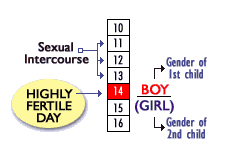 We, as women, like to believe that we are in tune with our bodies enough that we can feel dramatic changes such as pregnancy. Trying to get pregnant can be a frustrating, disheartening experience. "I thought it was for real, this time!" a woman may exclaim. Sometimes, we may feel like we have conceived, only to be told by doctors that we're not pregnant. Other times, we may think we have avoided pregnancy by following our ovulation cycles, only to find that we have conceived accidentally. Unfortunately, the female body is still full of mystery, and we have much to learn about it. Finding the most fertile time for an individual woman's eggs is similar to boiling eggs in water; you never know when they are ready!
We, as women, like to believe that we are in tune with our bodies enough that we can feel dramatic changes such as pregnancy. Trying to get pregnant can be a frustrating, disheartening experience. "I thought it was for real, this time!" a woman may exclaim. Sometimes, we may feel like we have conceived, only to be told by doctors that we're not pregnant. Other times, we may think we have avoided pregnancy by following our ovulation cycles, only to find that we have conceived accidentally. Unfortunately, the female body is still full of mystery, and we have much to learn about it. Finding the most fertile time for an individual woman's eggs is similar to boiling eggs in water; you never know when they are ready!
Ultrasound often gives results that show the progress of the pregnancy to be 1-2 weeks at variance with expectations of the doctors. These conceptions occur at time when they are quite sure they are safe. Doctors have traditionally felt that these instances result from "human error" on the part of the woman, and many of them might be. In other instances, how can conception occur in the apparent absence of ovulation? Dr. Eugen Jonas has an answer: There is a second cycle. In an adult woman one egg is released from the ovary in mid-cycle. However, there is also a capacity for this to occur at other times.
Spontaneous ovulation is a phenomenon long known about in medical circles, but little understood or explored. Since little has been understood about why and when it occurs it has always been a "rogue" element in fertility control.
There are four (4) days of possible and potential fertility during spontaneous ovulation each month. So, when conception is desired, it is preferable to make love within these four so-called "highly fertile" days.
If you have been diagnosed with "unexplained fertility," we can determine your individual, highly fertile (red) days for you. By utilizing these days, you can dramatically increase your chances of conception. Many women who had been considered infertile for many years became pregnant after the first proper use of highly fertile days.
Dr. Jonas has spent his entire medical career working with infertile volunteer couples in state and private hospitals and maternity clinics finding out when the second, spontaneous ovulation is happening. He has discovered that the timing of conception is the most important natural aid to fertility.
The Dr. Eugen Jonas Method® is able to determine very accurately your highly fertile days.
Using this method, you will have the best chance to conceive without drugs, chemicals, expensive treatments, herbs and other health hazards. We will provide you with your individual highly fertile days to determine when conception is most probable. You will learn how to use them in the section HOW TO .
For the conception, the fully RED days should be used. Sexual intercourse should happen one day before the fully "red" (highly fertile) days, which we will provide you. 85% pregnancies occured during these "red" highly fertile days. To increase your chances of conception, the sexual intercourse is recommended also on the other two preceding days, which makes altogether a 3-day highly fertile term preceding the fully red day. However, consideration should be also given to the individual ovulation cycle that is determined according to the menstruation period. Fifteen (15) days are to be added to the first day of the menstruation and this day is to be fully colored GREEN.
The best day to conceive is when the fully RED (highly fertile day) overlaps or coincides with the full GREEN (ovulation) day. Conception takes place in almost 99% of such cases.
Note: RED days are the days by which conception is determined. This is why sexual intercourse should occur one day before the red day.
Should the RED day fall during menstruation, gynaecologists do not recommend sexual intercourse, above all, due to hygienic reasons. However, many women are grateful for their child being conceived during menstruation.
For detailed instructions please refer also to the section HOW TO.


